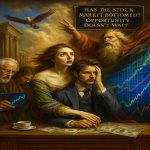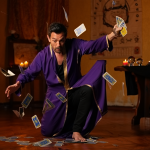
Cognitive Humility: Admit You’re Clueless—Then Watch Your Portfolio Thrive
April 11, 2025
Introduction: The Essence of Cognitive Humility
Cognitive humility isn’t weakness—it’s weaponized doubt. The kind that cuts through illusion and ego like tempered steel. It’s not the loud who survive in the markets—it’s the lucid.
Louis XI of France, the “Spider King,” spun webs of influence across Europe, not through brute force but through cunning restraint. “He who has not crossed the river yet should not laugh at him who is drowning.” That line? It’s not just a proverb. It’s an indictment of the overconfident investor. The river is the market—deep, shifting, and always colder than you think. Those who snicker from the bank’s safety often end up pulled under when they finally step in.
Cognitive humility means admitting your vision is flawed before the market blinds you. It’s the realization that every chart you read, every model you build, is merely scaffolding around a dynamic psychological organism. You’re not just analyzing prices—you’re watching a mirror that reflects your own fear, euphoria, and bias back at you.
It’s psychological aikido: using your uncertainty to pivot faster, think clearer, and survive longer.
In a world where most investors seek certainty, the cognitively humble seek advantage. Because when you’re not married to your thesis, you’re free to remarry reality.
The Role of Mass Psychology in Investing
The market isn’t a machine. It’s a mood—a fever dream built on collective emotion, held together by the thinnest threads of belief.
H.L. Mencken once said, “The most dangerous man to any government is the man who can think things out for himself.” The same goes for markets. The most dangerous investor to the herd is the one who doesn’t flinch when the VIX spikes, who doesn’t chase green candles, who sees fear not as a stop sign but as a scent trail.
This is the investor who reads sentiment like a tactician studies terrain. They ask: Are we in a mania? Is this apathy or exhaustion? Is this panic the real kind—or the fake-out before the bounce?
Understanding crowd psychology isn’t about watching CNBC panels or Twitter polls but listening beneath the surface: fund flows, option skews, insider activity, and the metaphysical pulse of the market’s unconscious.
In every bubble and bust, the crowd repeats the same script: delusion, euphoria, arrogance, disbelief, capitulation. Mass psychology is the market’s memory, scratched into every historical chart. Whether it’s the South Sea Bubble, the Dot-Com blowout, or the 2021 memestock inferno—it’s the same tragedy, wearing different makeup.
The investor who gets this isn’t early or late—they’re asynchronous. They don’t ride with the crowd; they use it like wind in a sail.
Integrating Technical Analysis with Behavioral Insight
Think of it this way: Technicals are the skeleton. Psychology is the blood.
You can have all the Fibonacci levels, RSI divergences, and moving average crossovers in the world—but if you don’t understand the behavioral temperature of the market, you’re charting a corpse.
Gaius Maecenas didn’t just bankroll Augustus—he curated Rome’s intellectual empire. He understood that power isn’t just strategy. It’s mood. Myth. Psychology. That’s the investor’s real terrain. It’s not the lines on the chart—it’s the minds moving behind them.
For example, technical indicators might flash “oversold.” But if sentiment is still euphoric, those levels mean nothing. Just like an RSI of 30 is meaningless if the crowd still believes it’s “buy the dip” season. The inverse is also true—sometimes charts break down while the crowd runs for cover. That’s the opportunity. That’s your inflection point.
Volume surges? They mean nothing unless you ask who’s buying—and why now. Is it institutions? Insiders? Or Reddit tourists front-running each other?
The cognitively humble investor doesn’t just see a cup-and-handle—they see the psychology of regret and revenge trades, of stop-loss clusters and FOMO buying. They know when a breakout isn’t a breakout—it’s a bull trap made from the bones of broken egos.
That awareness creates strategic space. When others are trapped in pattern-recognition loops, you’re operating on a deeper signal: fear index versus conviction, liquidity versus narrative, supply zone versus disbelief rally.
That’s when you stop reacting and start predicting the reaction.
Real-World Applications of Cognitive Humility and Psychology
Cognitive humility is not theory—it’s a battlefield-tested strategy. Warren Buffett isn’t just the Oracle of Omaha; he’s the patron saint of probabilistic thinking. His greatest strength isn’t conviction—it’s calibration. He admits mistakes fast, cuts losses faster, and learns obsessively. While others nurse broken egos, he retools. That’s not meekness. That’s tactical detachment.
Cosimo de’ Medici didn’t build a dynasty by brute force or balance sheets. He read the moods of the Republic like a Renaissance psychologist—knowing when to loan, when to bribe, when to vanish. He bankrolled artists and funded papal campaigns, not just for prestige but because he understood that power, like markets, moves in psychological undercurrents.
Most investors miss this: The greats aren’t just number crunchers. They’re mood readers. Pattern decoders. Mind-field tacticians. They know when the crowd is drunk on hope or trembling from ghosts.
To move like them, you must think in layers. Scan the chart. Question the consensus. Read the room—and the room behind the room.
Avoiding the Pitfalls of Overconfidence and Herd Mentality
Overconfidence doesn’t announce itself—it whispers. It hides in confirmation bias, in the dopamine rush of a green candle, in the illusion of control. And then it kills.
Every investor hears it: *You’ve got this. You’re smarter than the crowd. The market is wrong—*until it’s not.
Cognitive humility is your kill switch. It severs the feedback loop before the damage is done.
Oliver Cromwell’s warning—“Trust in God, but keep your powder dry”—wasn’t theology. It was psychological strategy. In markets, it means build conviction, but always plan for the blindside. That’s why the sharpest investors hedge against themselves. They diversify not out of fear, but out of respect for the unknown.
When the herd piles into tech, meme stocks, crypto, or AI hype—ask: What am I not seeing? Who’s on the other side of this trade—and why are they smiling?
Because the market is a mirror, and overconfidence is often just your own reflection—warped by euphoria and bravado.
Creating a Balanced Investment Strategy
A balanced strategy isn’t about 60/40 allocations or rebalancing spreadsheets—it’s about synchronicity. Technicals are tempo. Psychology is melody. The harmony lies in knowing when to trust the chart—and when to override it.
Paul Beatty’s satire teaches us what markets so often forget: institutions are fallible, logic is flawed, and conventional wisdom is usually the punchline of tomorrow’s joke. That same irreverence is your asset.
Don’t just track momentum. Ask what fuels it. Greed? Desperation? Institutional window dressing?
Every strategy must be flexible enough to bend with new data and ruthless enough to break old beliefs. Because in chaos, rigidity is a death sentence. But adaptivity? That’s alpha.
The Benefits of Continuous Learning and Adaptation
Stagnation is defeat disguised as comfort. The market is a kinetic organism—part animal, part algorithm. If you aren’t evolving, you’re already obsolete.
The great investors are never static. They steal techniques and test models, break systems, and then rebuild. They read outside finance, mine philosophy, biology, and art, and borrow tools from Sun Tzu, Seneca, and Taleb.
Louis XI knew this centuries ago. His strength wasn’t certainty—it was strategic paranoia. He saw alliances as temporary, enemies as future allies, and stability as an illusion. That’s why he survived—and ruled.
Today’s market demands the same. Every crash is a syllabus. Every rally is a trap. Every mistake is a thesis waiting to be written. The cognitively humble investor doesn’t just trade—they study the battlefield after every move.
Conclusion: The Path to Strategic Market Mastery
Cognitive humility is not just a trait. It’s a tactical edge, a form of mental jiu-jitsu—the ability to pivot without panic, learn without ego, and adapt without paralysis.
This mindset turns the market from a minefield into a terrain map. Your losses become coordinates. Your wins become a signal. And your psychology becomes your ultimate leverage.
The market will not reward your brilliance. It will punish your arrogance. It will grind your best ideas into compost if you refuse to change. But it will reward those who study, who question, who evolve.
So the real question isn’t “What’s the right stock?” It’s:
Do you have the psychological constitution to thrive in a system designed to break you?
Will you think like Louis XI—quiet, cunning, calculating? Like Maecenas—reading sentiment beneath the noise? Like Buffett—playing the long game with short-term precision?
Because the market doesn’t wait, and it doesn’t care.
But if you learn to dance with doubt, to build while others boast, and to shift when others freeze—
You don’t just survive.
You shape the chaos.










